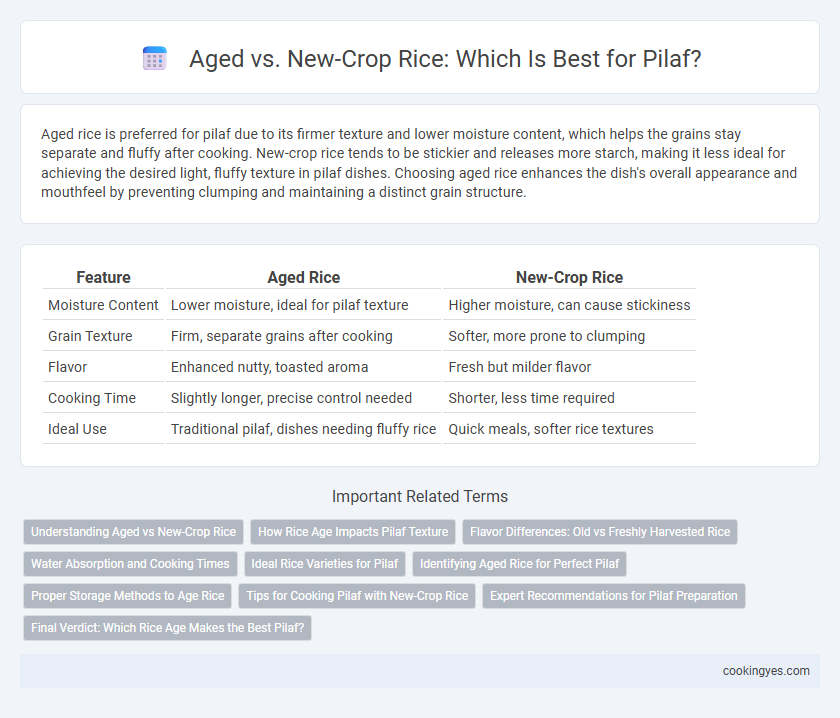Aged rice is preferred for pilaf due to its firmer texture and lower moisture content, which helps the grains stay separate and fluffy after cooking. New-crop rice tends to be stickier and releases more starch, making it less ideal for achieving the desired light, fluffy texture in pilaf dishes. Choosing aged rice enhances the dish's overall appearance and mouthfeel by preventing clumping and maintaining a distinct grain structure.
Table of Comparison
| Feature | Aged Rice | New-Crop Rice |
|---|---|---|
| Moisture Content | Lower moisture, ideal for pilaf texture | Higher moisture, can cause stickiness |
| Grain Texture | Firm, separate grains after cooking | Softer, more prone to clumping |
| Flavor | Enhanced nutty, toasted aroma | Fresh but milder flavor |
| Cooking Time | Slightly longer, precise control needed | Shorter, less time required |
| Ideal Use | Traditional pilaf, dishes needing fluffy rice | Quick meals, softer rice textures |
Understanding Aged vs New-Crop Rice
Aged rice features reduced moisture content, resulting in firmer, less sticky grains that separate well in pilaf, creating a fluffy texture ideal for absorbing flavors. New-crop rice retains higher moisture levels, causing grains to be softer and stickier, which may lead to clumping and a less distinct pilaf structure. Selecting aged rice enhances pilaf quality by ensuring individual grain integrity and optimal texture during cooking.
How Rice Age Impacts Pilaf Texture
Aged rice has a lower moisture content, which helps grains remain separate and fluffy when cooked, ideal for pilaf's desired texture. New-crop rice, with higher moisture, tends to be stickier and may clump, making pilaf less distinct in grain separation. Choosing aged rice enhances pilaf's fluffy and firm texture, essential for an authentic dish.
Flavor Differences: Old vs Freshly Harvested Rice
Aged rice used in pilaf offers a firmer texture and enhanced nutty flavor due to the moisture loss during storage, which allows it to absorb spices and broth evenly without becoming mushy. Freshly harvested rice tends to have a higher moisture content, resulting in a stickier texture and more subtle, grassy notes that can sometimes dilute the complex seasoning of pilaf. Choosing aged rice improves the dish's overall flavor depth and creates a distinct, fluffy pilaf ideal for capturing aromatic spices.
Water Absorption and Cooking Times
Aged rice absorbs water more efficiently during pilaf preparation, resulting in fluffier grains and a firmer texture due to reduced moisture content accumulated over time. New-crop rice typically requires shorter cooking times but can absorb water unevenly, often producing stickier or softer pilaf textures. Adjusting water ratios and cooking durations between aged and new-crop rice is essential for optimal pilaf consistency.
Ideal Rice Varieties for Pilaf
Aged rice varieties, such as Basmati and Jasmine, are ideal for pilaf due to their lower moisture content and firmer grains, which help maintain separation after cooking. New-crop rice retains more moisture, making it more prone to clumping and less suitable for the fluffy texture desired in pilaf dishes. Selecting aged rice ensures the perfect absorption of broth and spices while preserving individual grain integrity for authentic pilaf preparation.
Identifying Aged Rice for Perfect Pilaf
Aged rice is ideal for pilaf due to its lower moisture content, which prevents clumping and yields fluffy, separate grains. Identifying aged rice involves checking for hard, dry kernels that break easily, a result of storage lasting from several months to over a year. New-crop rice, with higher moisture, tends to stick together and may produce a denser texture unsuitable for traditional pilaf.
Proper Storage Methods to Age Rice
Proper storage methods are crucial for aging rice to enhance its texture and flavor in pilaf dishes. Store rice in airtight containers in a cool, dry, and dark place to prevent moisture absorption and pest infestation. Maintaining a stable temperature around 50-60degF slows down starch degradation, allowing aged rice to develop a firmer, fluffier consistency ideal for pilaf preparation.
Tips for Cooking Pilaf with New-Crop Rice
New-crop rice contains higher moisture and tends to be softer and stickier, making it essential to rinse thoroughly and adjust water quantity when cooking pilaf to avoid excess mushiness. Soaking new-crop rice for 20-30 minutes before cooking helps achieve a firmer texture and more even grain separation. Use slightly less water than the traditional pilaf ratio and monitor cooking time closely to ensure perfectly fluffy results.
Expert Recommendations for Pilaf Preparation
Expert recommendations for pilaf preparation emphasize using aged rice due to its lower moisture content and firmer texture, which prevents clumping and yields separate, fluffy grains. New-crop rice, with higher moisture levels, tends to cook stickier and may require adjustment in water quantity and cooking time. Choosing aged rice ensures consistent texture and optimal absorption of spices and broth critical for authentic pilaf flavor.
Final Verdict: Which Rice Age Makes the Best Pilaf?
Aged rice is preferred for pilaf due to its firmer texture and reduced moisture content, which prevents clumping and ensures fluffy, separate grains. In contrast, new-crop rice contains higher moisture levels, resulting in a stickier consistency and less distinct grains. For the best pilaf, aged rice consistently delivers superior texture and flavor, making it the optimal choice for chefs and home cooks alike.
Aged vs New-crop for pilaf Infographic

 cookingyes.com
cookingyes.com